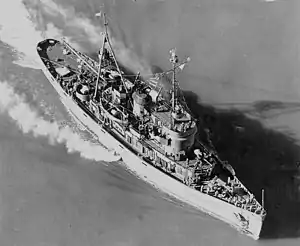USS Cahuilla (ATF-152)
USS Cahuilla (ATF-152) was an Abnaki class fleet tug in the service of the United States Navy during World War II. In 1961 she was sold to the Argentine Navy as ARA Irigoyen (A-1) where she served until 2009 when she became a Museum ship.
.JPG.webp) | |
| History | |
|---|---|
| Name: | USS Cahuilla |
| Builder: | Charleston Shipbuilding & Drydock Co. |
| Laid down: | as Cahuilla (AT-152) |
| Launched: | 2 November 1944 |
| Commissioned: | 10 March 1945 |
| Decommissioned: | 27 June 1947 |
| Reclassified: | Fleet Ocean Tug (ATF-152), 15 May 1944 |
| Stricken: | 9 July 1961 |
| Fate: | Transferred under the Security Assistance Program to Argentina, 9 July 1961 |
| History | |
| Name: | ARA Comandante General Irigoyen (A-1) |
| Acquired: | 9 July 1961 |
| Out of service: | 2009 |
| Status: | Museum ship |
| General characteristics | |
| Class and type: | Abnaki class fleet tug |
| Displacement: |
|
| Length: | 205 ft (62 m) |
| Beam: | 38 ft 6 in (11.73 m) |
| Draft: | 15 ft 5 in (4.70 m) |
| Propulsion: | 4 × General Motors 12-278A Diesel-electric engines, 3,000 hp (2,237 kW), single screw |
| Speed: | 16 knots (18 mph; 30 km/h) |
| Complement: | 85 |
| Armament: |
|
US Navy service
She was laid down as Cahuilla (AT-152) at Charleston Shipbuilding and Dry Dock Co. of Charleston, South Carolina; redesignated fleet ocean tug (ATF-152) on 15 May 1944; launched on 2 November 1944; and commissioned USS Cahuilla (ATF-152) on 10 March 1945.
World War II Pacific Theatre operations
USS Cahuilla's first service to the U.S. Navy was a brief tour as antisubmarine attack teacher at Norfolk, Virginia. From there she sailed 18 April 1945 towing USS Pegasus (AK-48) for Pearl Harbor. After delivering her tow 24 May, the fleet tug sailed for Guam, where she took a string of pontoon barges in tow for Okinawa.
From 26 July to 6 August, she served to escort convoys and as rescue tug for the ships passing through the dangerous waters off Okinawa, subject to the desperate suicide attacks of Japanese aircraft.
End-of-War operations
The end of the war found USS Cahuilla at sea, bound for salvage operations at Eniwetok, from which she returned to take part in the occupation of Nagasaki, Japan, until 16 October. From that time she was based on Okinawa for rescue and tow operations until 14 February 1946.
USS Cahuilla continued to offer towing service to fleet units, and rescue work to naval and merchant ships, calling at Pearl Harbor, Kwajalein, and ports of the west coast and Panama Canal Zone until January 1947.

Decommissioning
USS Cahuilla was decommissioned on 27 June 1947 at San Diego, California. Laid up in the Pacific Reserve Fleet, she was struck from the Naval Register and later transferred, under the Security Assistance Program, to Argentina on 9 July 1961.
Argentine Navy service
In 1961 the tug was acquired by the Argentine Navy as an Aviso and renamed ARA Comandante General Irigoyen (A-1) in honor of Spaniard Don Matías de Irigoyen y de la Quintana who was War Secretary between 1815 and 1819. During the 1982 Falklands War she was stationed near the Isla de los Estados island and served in the rescue of the ARA General Belgrano survivors.[1] During her career she also acted as an Antarctic support ship and as a submarine force divers training ship.[2] On 29 September 2009 after 400.000 miles sailed in the South Atlantic, she was finally retired.[3]
Museum
In January 2010, she was transferred to the care of the municipality of San Pedro, Buenos Aires Province and permanently moored as the Buque Museo Irigoyen, the third Argentine museum ship, opening to the public in May 2010.[2] On 5 November 2020 the tug was found to be listing dangerously after taking water and assistance was sought from the Navy to prevent her sinking or breaking free.[4]
References
This article incorporates text from the public domain Dictionary of American Naval Fighting Ships. The entry can be found here.
Notes
- ARA Irigoyen 1982 Malvinas (in Spanish)
- "Inauguraron el buque museo "Comandante General Irigoyen"". Gaceta Marinera (in Spanish). Armada Argentina. 28 May 2010. Archived from the original on 23 July 2011. Retrieved 12 November 2020.
- Pasan a reserva al ARA Irigoyen (in Spanish)
- Morales, Fernando (8 November 2020). "El remolcador Irigoyen se hunde en las costas de San Pedro, mientras los vecinos y la Armada Argentina intentan evitar su naufragio". Infobae (in Spanish). Mexico City. Archived from the original on 9 November 2020. Retrieved 12 November 2020.
Further reading
- (in Spanish)"AVISO A.R.A. "Comandante Gral.Irigoyen"" - Histarmar website (accessed 22016-07-9)
- (in Spanish)"Buque Museo Aviso (A-1) A.R.A. “Comandante General Irigoyen”" - Histarmar website (accessed 2016-07-18)
- (in Spanish)"Despedida del Aviso ARA Irigoyen" by A. Becquer Casaballe - ATNA website (accessed 2016-07-18)
External links
- Buque Museo Irigoyen - official site (in Spanish)
- NavSource Online: Service Ship Photo Archive - AT-152 / ATF-152 Cahuilla
- An article on the Buque Museo Irigoyen opening (in Spanish)
- Video: Irigoyen's last trip
- An article on ship's Argentine service history - Histarmar (in Spanish)